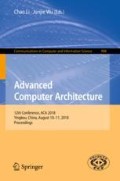Abstract
Deep convolutional neural networks (DNNs) achieve state-of-the-art accuracy but at the cost of massive computation and memory operations. Although highly-parallel devices effectively meet the requirements of computation, energy efficiency is still a tough nut.
In this paper, we present two novel computation sequences, \(N\!H\!W\!C_{fine}\) and \(N\!H\!W\!C_{coarse}\), for the DNN accelerators. Then we combine two computation sequences with appropriate data layouts. The proposed modes enable continuous memory access patterns and reduce the number of memory accesses, which is achieved by leveraging and transforming the local data reuse of weights and feature maps in high-dimensional convolutions.
Experiments with various convolutional layers show that the proposed modes made up of computing sequences and data layouts are more energy efficient than the baseline mode on various networks. The reduction for total energy consumption is up to 4.10\(\times \). The reduction for the off-chip memory access latency is up to 5.11\(\times \).
Access this chapter
Tax calculation will be finalised at checkout
Purchases are for personal use only
References
Albericio, J., et al.: Bit-pragmatic deep neural network computing. In: Proceedings of the 50th Annual IEEE/ACM International Symposium on Microarchitecture, pp. 382–394. ACM (2017)
Alwani, M., Chen, H., Ferdman, M., Milder, P.: Fused-layer CNN accelerators. In: 2016 49th Annual IEEE/ACM International Symposium on Microarchitecture (MICRO), pp. 1–12. IEEE (2016)
Bastoul, C.: Code generation in the polyhedral model is easier than you think. In: Proceedings of the 13th International Conference on Parallel Architectures and Compilation Techniques, pp. 7–16. IEEE Computer Society (2004)
Chen, T., et al.: Diannao: a small-footprint high-throughput accelerator for ubiquitous machine-learning. In: ACM Sigplan Notices, vol. 49, pp. 269–284. ACM (2014)
Chen, Y.-H., Emer, J., Sze, V.: Eyeriss: a spatial architecture for energy-efficient dataflow for convolutional neural networks. In: 2016 ACM/IEEE 43rd Annual International Symposium on Computer Architecture (ISCA), pp. 367–379. IEEE (2016)
Chen, Y., et al.: Dadiannao: a machine-learning supercomputer. In: Proceedings of the 47th Annual IEEE/ACM International Symposium on Microarchitecture, pp. 609–622. IEEE Computer Society (2014)
Cireşan, D.C., Meier, U., Gambardella, L.M., Schmidhuber, J.: Deep, big, simple neural nets for handwritten digit recognition. Neural Comput. 22(12), 3207–3220 (2010)
Collobert, R., Weston, J.: A unified architecture for natural language processing: deep neural networks with multitask learning. In: Proceedings of the 25th International Conference on Machine Learning, pp. 160–167. ACM (2008)
Deng, L., et al.: Recent advances in deep learning for speech research at microsoft. In: 2013 IEEE International Conference on Acoustics, Speech and Signal Processing (ICASSP), pp. 8604–8608. IEEE (2013)
Ding, C., et al.: C IR CNN: accelerating and compressing deep neural networks using block-circulant weight matrices. In: Proceedings of the 50th Annual IEEE/ACM International Symposium on Microarchitecture, pp. 395–408. ACM (2017)
Fowers, J., Brown, G., Cooke, P., Stitt, G.: A performance and energy comparison of FPGAs, GPUS, and multicores for sliding-window applications. In: Proceedings of the ACM/SIGDA International Symposium on Field Programmable Gate Arrays, pp. 47–56. ACM (2012)
Gupta, S., Agrawal, A., Gopalakrishnan, K., Narayanan, P.: Deep learning with limited numerical precision. In: Proceedings of the 32nd International Conference on Machine Learning (ICML-15), pp. 1737–1746 (2015)
Han, S., Mao, H., Dally, W.J.: Deep compression: compressing deep neural networks with pruning, trained quantization and huffman coding. arXiv preprint arXiv:1510.00149 (2015)
Krizhevsky, A., Sutskever, I., Hinton, G.E.: Imagenet classification with deep convolutional neural networks. In: Advances in Neural Information Processing Systems, pp. 1097–1105 (2012)
LeCun, Y., Bottou, L., Bengio, Y., Haffner, P.: Gradient-based learning applied to document recognition. Proc. IEEE 86(11), 2278–2324 (1998)
Li, C., Yang, Y., Feng, M., Chakradhar, S., Zhou, H.: Optimizing memory efficiency for deep convolutional neural networks on GPUS. In: SC16: International Conference for High Performance Computing, Networking, Storage and Analysis, pp. 633–644. IEEE (2016)
Li, Z., et al.: Laius: an 8-bit fixed-point CNN hardware inference engine. In: 2017 15th IEEE International Symposium on Parallel and Distributed Processing with Applications (ISPA), pp. 143–150. IEEE (2017)
Reagen, B., et al.: Minerva: enabling low-power, highly-accurate deep neural network accelerators. In: Proceedings of the 43rd International Symposium on Computer Architecture, pp. 267–278. IEEE Press (2016)
Rosenfeld, P., Cooper-Balis, E., Jacob, B.: Dramsim2: a cycle accurate memory system simulator. IEEE Comput. Arch. Lett. 10(1), 16–19 (2011)
Simonyan, K., Zisserman, A.: Very deep convolutional networks for large-scale image recognition. arXiv preprint arXiv:1409.1556 (2014)
Wang, C., Gong, L., Qi, Y., Li, X., Xie, Y., Zhou, X.: Dlau: a scalable deep learning accelerator unit on FPGA. IEEE Trans. Comput. Aided Des. Integr. Circuits Syst. 36(3), 513–517 (2017)
Wei, X., et al.: Automated systolic array architecture synthesis for high throughput CNN inference on FPGAs. In: 2017 54th ACM/EDAC/IEEE Design Automation Conference (DAC), pp. 1–6. IEEE (2017)
Author information
Authors and Affiliations
Corresponding author
Editor information
Editors and Affiliations
Rights and permissions
Copyright information
© 2018 Springer Nature Singapore Pte Ltd.
About this paper
Cite this paper
Nie, Z., Li, Z., Wang, L., Guo, S., Dou, Q. (2018). Memory Bandwidth and Energy Efficiency Optimization of Deep Convolutional Neural Network Accelerators. In: Li, C., Wu, J. (eds) Advanced Computer Architecture. ACA 2018. Communications in Computer and Information Science, vol 908. Springer, Singapore. https://doi.org/10.1007/978-981-13-2423-9_2
Download citation
DOI: https://doi.org/10.1007/978-981-13-2423-9_2
Published:
Publisher Name: Springer, Singapore
Print ISBN: 978-981-13-2422-2
Online ISBN: 978-981-13-2423-9
eBook Packages: Computer ScienceComputer Science (R0)


